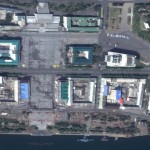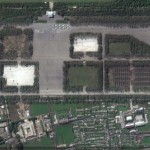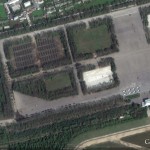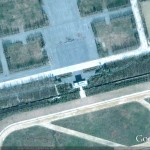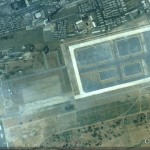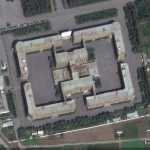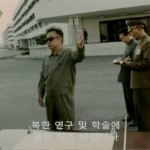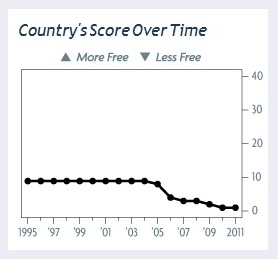UPDATE 1: By coincidence NK Leadership Watch and I posted on a similar topic today. See his post and analysis here.
ORIGINAL POST: Today the Daily NK reported that preparations were underway for another KPA military parade:
A high level government official revealed today, “North Korea has been mobilizing military personnel and equipment to practice for the military parade at Mirim Airfields near Pyongyang. This practice has been taking place since even before the death of Kim Jong Il.”
The official explained the reason for the ongoing parade practice as part of preparations to commemorate Kim Il Sung’s birthday (April 15) and the Mlitary Foundation Day (April 25).
The military parade practice has so far involved the Worker and Peasant Red Guard, which is made up of currently-serving soldiers and reservists, mobilized with the latest-model tanks, armored cars, as well as short and medium range KN-02 and Musudan missiles.
The official added, “North Korea conducts parades on anniversaries such as the Military Foundation Day and other national holidays. Looking at the speed and scale of preparations currently underway, it seems more likely that the parade will take place in April rather than on February 16, Kim Jong Il’s birthday.”
The logistics of these parades are enormous. I learned a lot about them back in November at a meeting with Osamu Eya in Japan. Among the many things we discussed, I asked him where the North Korean military practices their parades through Kim Il-sung Square. He answered with a single word: “Mirim”.
Now I am kind of embarrassed to admit that I never saw the resemblance (because I thought of the Mirim area as a runway strip and because the two places are not geographically laid out in the same directions). Once you rotate the satellite images and set them next to each other, however, there is no denying that the KPA has a Kim Il-sung Square-sized practice area from which to rehearse its grand military parades.
Pictured above (Google Earth): (L) Kim Il-Sung Square, (R) Mirim parade practice area.
Looking at the most current Google Earth satellite imagery (2010-10-6) we can see vehicles already practicing for their next parade:
In this Google Earth image (2006-11-11) we can see people practicing in the area:
Going back to the oldest available satellite image on Google Earth (2000-6-12) the use of the facility as a practice area is a little more clear. We can also see some of what remains of the original landing strip in this photo:
But Mirim is not just a practice filed. It also contains facilities to house and feed the thousands of people who come to practice. Just to the left of the field is the April 25 Hotel:
According to KCNA (1998-9-30):
The April 25 Hotel has been built on the outskirts of Pyongyang as a monumental edifice in the era of the Workers’ Party. The hotel with a total floor space of more than 134,000 square metres and accommodation for 20,000 guests has bedrooms, cultural and welfare facilities and cook equipment on a highest level. It will serve servicemen and civilians who participate in national military and civic events. Soldier-builders successfully finished this gigantic project–erection of buildings, assembling of equipment and arrangement of the area–in a little more than one year. A ceremony for the completion of the hotel took place on Tuesday. Present at the ceremony were Jo Myong Rok, Kim Il Chol, Kye Ung Thae and others. A congratulatory message of the Workers’ Party of Korea Central Committee was conveyed to the soldier-builders and helpers who had performed feats in the hotel construction. The message noted that the April 25 Hotel, a monumental edifice of the era, has been built in a short span of time under the present conditions that all the people have to overcome manifold trials and hardships in their advance. it could be done only by the revolutionary army of Korea who knows no impossibility, and it is a proud fruition produced by the might of the army and people rallied around the party as one in mind, it stressed. Highly praising the soldier-builders and helpers for demonstrating again the potentials and stamina of socialist Korea by completing the hotel, the message expressed the belief that they would make greater success in carrying out their revolutionary duties. Jo Myong Rok made a report at the ceremony. The reporter said that the heroic and proud feats performed by servicemen in the noble work to carry out the WPK’s grand plan for construction will be always remembered by the fatherland and handed down to posterity.
KCNA reported on 1998-10-8 that Kim Jong-il visited the hotel:
Pictured above: Kim Jong-il giving “on the spot guidance” at the 4.25 Hotel
[Kim Jong-il] then went to the April 25 Hotel which was newly built on Mirim plain. Looking round the interior and exterior of the hotel including a bedroom, a washroom, a dining hall and a kitchen, he learned how the hotel had been built. He highly praised soldiers and helpers for having built the hotel in a short span of time and contributed to demonstrating the potential and stamina of socialist Korea once again. He said the construction of the hotel in a short span of time is a miracle that can be worked only by the heroic Korean People’s Army (KPA) which is intensely loyal to the party. He added that the country will always remember the soldiers’ heroic feats and proud achievements in socialist construction. He called for equipping the hotel, an asset of eternal value for the army and people, with better facilities, planting many trees around the hotel, creating a pleasure park and providing those who stay in the hotel with good conditions for cultured life. As many servicemen and civilians will use the hotel, they should be given best services, he said, and gave the hotel important tasks for its management and operation. The Chairman of the DPRK National Defence Commission was accompanied by director of the General Political Department of the KPA Jo Myong Rok, chief of the general staff of the KPA Kim Yong Chun, Minister of the People’s Armed Forces Kim Il Chol and general officers of the KPA.
This hotel was built at the time the DPRK was experiencing the “Arduous March” (Forced March)–a famine which killed up to a million people. Despite the acute shortage of food and a breakdown of the DPRK’s revolutionary social contract, KCNA listed this hotel as one of the great accomplishments of the North Koreans during this time (1998-12-31):
This year proud successes have been reported from the DPRK in face of difficulties brought on by the combined effects of the never-ceasing campaign of the imperialists to stifle the DPRK and years of natural disasters. The most remarkable success gained in the forced march this year is artitifical satellite “Kwangmyongsong 1” which was launched into orbit on august 31. The scientists and technicians of Korea launched into orbit the first artificial satellite, a product of their own wisdom and technology, fully demonstrating the national power of Korea with a powerful scientific and technical force and the solid foundations of the independent national economy. Bulky April 25 Hotel and September 9 Street sprang up in Pyongyang to commemorate 50 years of the DPRK (September 9). The hotel with modern equipment and accommodation for 20,000 is on the east outskirts of the capital city. The street linking Pyongyang Airport to the Kumsusan Memorial Palace, the sacred temple of Juche, gave a major face-lifting to the northwest area of the capital city with bridges of special characteristics, flats for thousands of households, ornamental forests, scores of metres wide, on either side of the highway in good harmony with landscape. Thousands of minor power stations were built across the country this year. The locally-built minor power stations in Jagang Province meet the needs for the lighting of the flats for more than 100,000 households and the production of local-industry factories. Flats for 10,000 households in Chongjin, an industrial city, benefit from electric heating. A growing number of cities, counties and units are offsetting the demands for electricity with electric energy turned out at minor power stations. The Huichon General Machine Tool Plant produced hundreds of machine tools in a matter of a few months. In the railway transport diesel engine locomotives were converted into electric locomotives called “forced march.” 60 kilometre-odd-long railroad between Haeju and Ongjin, between singangryong and Pupho in the central area of the country was switched over to a broad-gauge one. The Pyongyang Integrated Circuits Factory, salt refineries and other industrial establishments were commissioned or completed throughout the country. As a result, a more solid economic foundation of the nation was laid.
